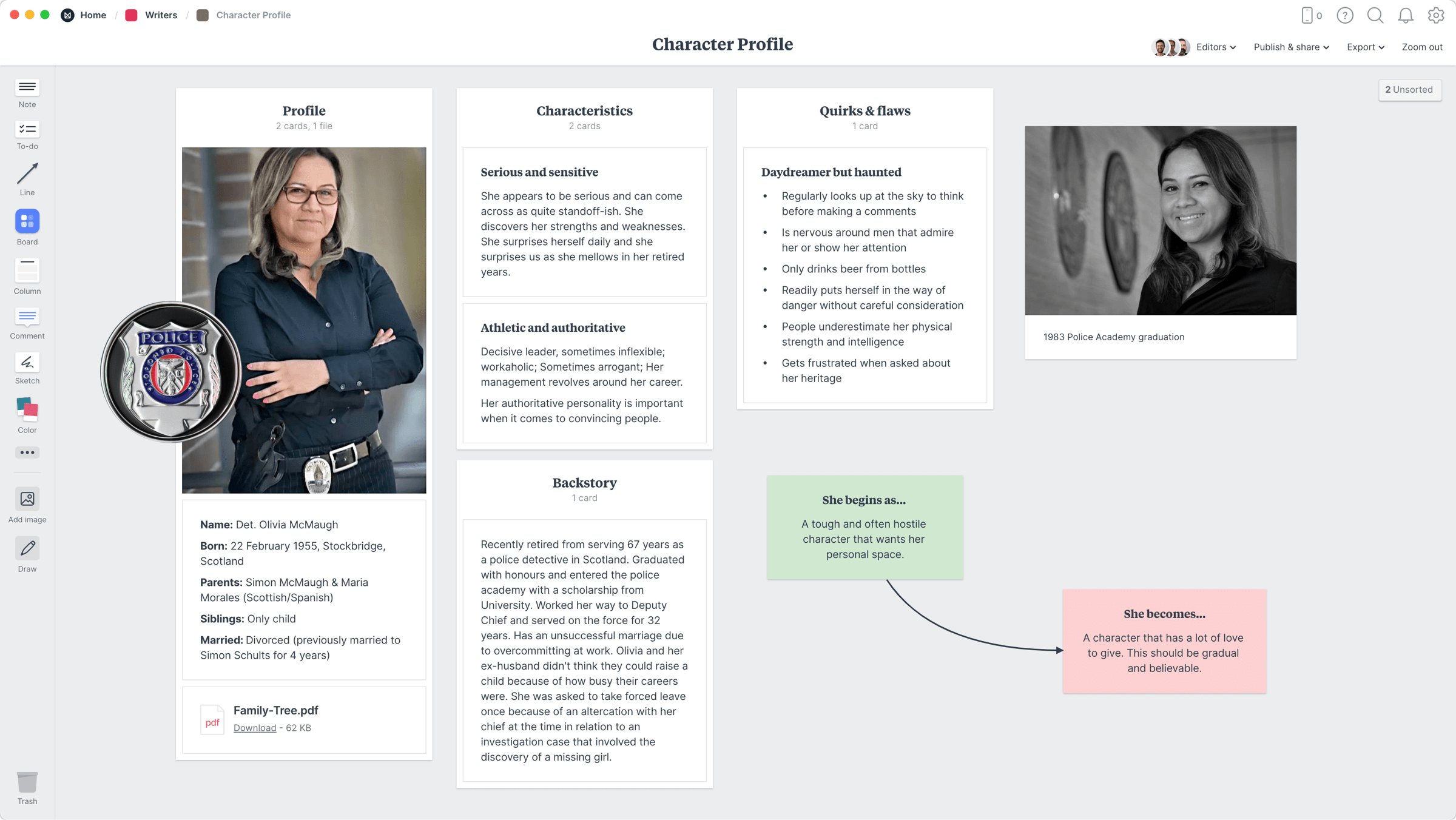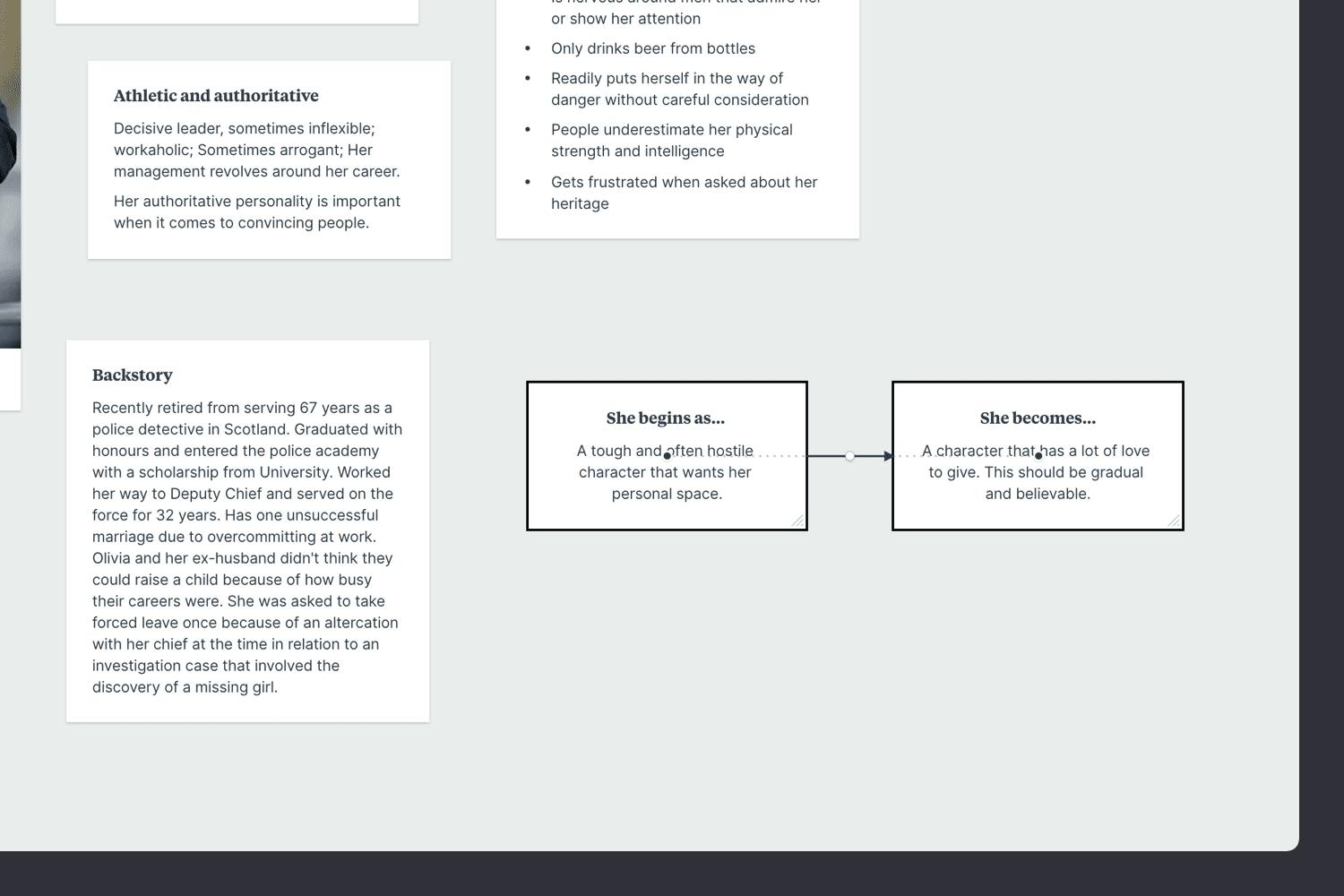Create your character
Get started for free with Milanote's easy to use character profile template.
Create your characterSign up for free with no time limit

Follow this step-by-step guide to learn the modern process of developing fictional characters in Milanote, a free tool used by top creatives.

One of the most integral parts of any story is crafting relatable and vivid characters. As writer Ernest Hemingway said, “When writing a novel a writer should create living people; people not characters. A character is a caricature.”
The character profile is a popular technique for developing genuine personas for your story. Depending on the project or person, some stories are born out of a character, while others begin with a plot that in turn shapes the characters. A detailed character profile will help to shape a narrative as well as provide a handy reference point for their personality traits, backstory, goals, flaws, and challenges.
Whether you’re developing a character for your novel, screenplay, video game, or comic, this guide will take you through every step to bring them to life.
A character might start as a bundle of random ideas, traits and plot points from a story outline, so it’s important to bring everything together in one place. A character archetype can help narrow your focus. There are twelve common archetypes or personas that we recognize across literature, mythology, and the human experience: The Innocent, Everyman, Hero, Outlaw, Explorer, Creator, Ruler, Magician, Lover, Caregiver, Jester, and Sage.
Archetypes provide guidelines for behaviors, emotions, and actions. For example, the Explorer is naturally curious, restless, and driven to push boundaries, such as detective Sherlock Holmes or Huckleberry Finn. Experiment with your archetype—layer characteristics or even transform them from one to another as the storyline progresses.

Create a new board for your character profile.
Drag a board out from the toolbar. Give it a name, then double click to open it.
Add an image to represent your character.
Click the "Upload file" button or just drag a file onto your board. You can add images, logos, documents, videos, audio, and much more.
Once you've defined an initial archetype, you can begin to shape the character and make them original. Consider the emotional connection between your audience and your character, and work towards the desired outcome. You may find that switching the age and gender of a character can lead to very different responses from your reader. Here are a few other examples you could use to create a unique character:

Add a note to describe their charactaristics.
Start typing then use the formatting tools in the left-hand toolbar.
Your character's backstory describes the journey they have taken up to this point. It allows you to explore their fears, weaknesses, and motivations and to define their purpose. You can explain the character's methods and evaluations—why they act the way that they do, the choices they make, and how it drives the individual forward. Are they making progress towards their goal, or making things worse?
To really round out the character, give them a personality that stretches beyond the story itself. Some aspects of their personality will not make it into the story but will help to inform the decisions that they make. Here are a few areas to consider when crafting an interesting backstory:

Add a note to describe their backstory.
Start typing then use the formatting tools in the left-hand toolbar.
Your character should come from an authentic place. That means that the character probably has some contradictions that make them a little out of the ordinary. If a character is too simplistic, it can feel cliched. Character flaws such as overconfidence, impatience, or recklessness can add new dimensions to a hero and make them feel more relatable. Here are a few other examples to consider:

Add a note to describe their quirks and flaws.
Start typing then use the formatting tools in the left-hand toolbar.
A believable character grows and changes as your story evolves. Just like real people, they adapt and respond to life's events.
Consider where your character starts out and how they change alongside developments in the story. How do they overcome their initial obstacles? For example, do they learn new skills, gain a fresh perspective or make new relationships that lead to their success?

Add notes to describe the change in your character.
Start typing then use the formatting tools in the left hand toolbar.
Even if you're writing a novel, visual references and inspiration can help bring your character to life. There are lots of fantastic sites where you can find great visual inspiration for free, like Pinterest or Google Images. You can also create a character moodboard at this stage to help explore all aspects of their appearance. See our guide on creating moodboards for a novel to learn more.

Use the built-in image library.
Search over 3 million beautiful photos powered by Pexels then drag images straight onto your board.
Add image files to your board.
Click the "Upload file" button or just drag a file onto your board. You can add images, logos, documents, videos, audio and much more.
Once you have everything you need, it's time to organize your content into logical topics. There's no right or wrong way to do this. The goal is to make your character profile easy to scan and reference as you're writing the story.

Use Columns to group related content
Name it, then drag any relevant notes or images into your column
It's important not to fall into the trap of giving just one character too much responsibility for the drama in your story. Work on additional characters that compliment and contrast the traits of your main character. You can repeat the above process to develop a whole cast of characters that help bring your novel to life. Creating a character relationship map can be a great way to visualize their relationships (good or bad).

Now that you've created a unique fictional character, you have a great reference to use while writing your story. Use the template below to start inventing your character or read our full guide on how to plan a novel.
